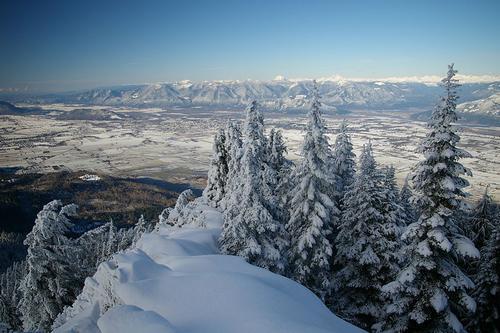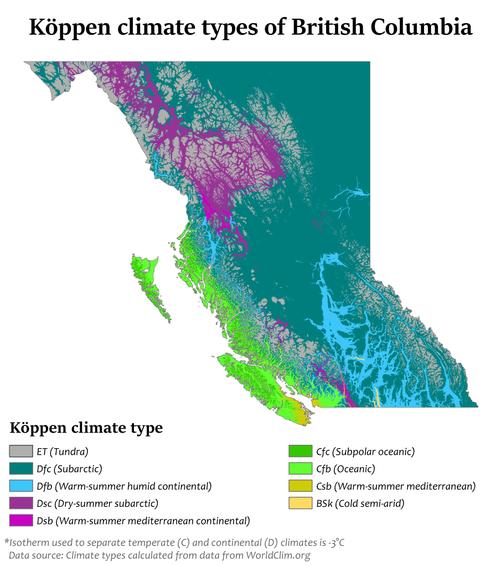BRITISH COLUMBIA
Climate and Weather

Climate and Weather
Popular destinations CANADA
| Alberta | British columbia | Manitoba |
| New brunswick | Newfoundland and labrador | Northwest territories |
| Nova scotia | Nunavut | Ontario |
| Prince edward island | Quebec | Saskatchwan |
| Yukon |
Climate and Weather

British Columbia has a varied climate due to the influence of the Pacific Ocean with its warm gulf currents and the north-south mountain ranges, with the eastern slopes in the rain shadow and the western slopes receiving the most rain. Large differences in a relatively small area are possible: for example, in the south of the Fraser Canyon there is an average of 1770 mm of rainfall per year, 150 km further in the same canyon, Ashcroft is the driest place in British Columbia (150 mm of precipitation per year).
Summers on the south coast are warm and sunny, up to a maximum of about 25°C. The temperature is pleasantly tempered by sea breezes. Canada's highest temperatures are regularly recorded in southern British Columbia, between Vancouver and Kamloops: in the town of Lytton, the highest temperature ever recorded in Canada is 44°C. In winter it rains regularly and the minimum temperatures during the day are around freezing. In summer there are rain storms and in winter it can snow in Vancouver or on Vancouver Island for a very long time. Annually there is about 2000 mm precipitation in this area. A place like Prince Rupert in western British Columbia on Kaien Island has an average of about 200 rainy days a year and has the dubious honor of being the least sunny place on earth.
The climate in the Okanagan Valley is strongly influenced by the mountainous coast, which separates this region from the Lower Mainland. The mountains ensure that in summer cool air from the valley does not penetrate and in winter cool air is brought in from the polar region. In summer there is little precipitation (an average of 310 mm per year) and it is very warm. The extreme temperatures are between -18°C in winter and 32°C in summer. Some parts are so arid that there is talk of desertification, complete with cacti and rattlesnakes.
The climate in the Okanagan Valley is strongly influenced by the mountainous coast, which separates this region from the Lower Mainland. The mountains ensure that in summer cool air from the valley does not penetrate and in winter cool air is brought in from the polar region. In summer there is little precipitation (an average of 310 mm per year) and it is very warm. The extreme temperatures are between -18°C in winter and 32°C in summer. Some parts are so arid that there is talk of desertification, complete with cacti and rattlesnakes.
Central and northern British Columbia have temperature differences that are becoming more and more extreme. For example, the Peace River district has extremes between -29°C and 27°C. The arctic influences in the northeast are obvious, cold winters with lots of snow and short, cold and wet summers. In winter there is an average of 55 centimeters of snow.
British Columbia also has a number of microclimates. One is in southern British Columbia near the town of Lillooet, which has a semi-arid climate in the Fraser Canyon with between 200-300mm of precipitation per year and some of the highest temperatures in Canada.
 Climate types in British Columbia according to KöppenPhoto: Adam Peterson CC BY-SA 4.0no changes made
Climate types in British Columbia according to KöppenPhoto: Adam Peterson CC BY-SA 4.0no changes made
Sources
BBC - Country Profiles
British Columbia and the Rockies
Michelin Apa Publications
Canada
Cambium
Canada
Lonely Planet
CIA - World Factbook
Elmar Landeninformatie
Jepson, Tim / Vancouver en de Canadese Rockies
Wat & Hoe
Leigh Fleming, Janet / British Columbia : a walking guide
Cicerone
Ohlhoff, Kurt Jochen / Canada west & Alaska
ANWB
Phenix, Penny / Canada
Wat & Hoe
The rough guide to Canada
Rough Guides
Struijk, Aad / West-Canada
Elmar
Veldt, Marc / Canada
Gottmer/Becht
Ver Berkmoes, Ryan / British Columbia & the Yukon
Lonely Planet
Wagner, Heike / West-Canada : Alberta, British Columbia
Lannoo
Wikipedia
Last updated December 2025Copyright: Team The World of Info